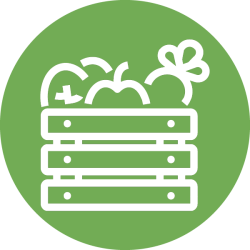Food Justice for All


Significance:
To promote well-being and improve outcomes for everyone in Washington, we must ensure that everyone has access to healthy, affordable, and culturally appropriate food that is produced through ecologically sound and sustainable methods as well as the opportunity to define their own food and agriculture systems.
Food justice is a series of complex and deep relationships between food, race, health, income, and culture. Food availability and affordability are critical links to understanding health outcomes. Understanding the price of food and the options available for people in different geographies in Washington provides insights into chronic diseases such as obesity, and community conditions, such as poverty.
To create a system a system where everyone, regardless of race, income, or geographic location, has equal access to nutritious, affordable, and culturally appropriate food. It also involves addressing systemic inequities in food production, distribution, and access, as well as ensuring that food systems are sustainable, community-driven, and resilient. Furthermore, we must address the intentional actions and policies that have created and continue to perpetuate inequities as well as the historical, political, social and economic systems that reinforce food insecurities.

Food Access
The type of food available for purchase in a community influences what people consume. This is important because food consumption influences health outcomes. For example, people living near grocery stores are more likely to meet fruit and vegetable requirements incurring a healthy diet and reducing risk of chronic diseases such as diabetes and obesity. Conversely, those living in areas with a higher concentration of fast-food restaurants and convenience stores are at an elevated risk to make food choices that include a higher calorie diet, and consuming fewer fruits and vegetables, which heightens the risk of chronic disease.
Food Affordability
Percent of Students with Free or Reduced-Price Meals
Student eligibility for free or reduced-price meals is a reflection of overall household income. Given that the food hardship measure is limited to English and Spanish speaking individuals with a telephone, the measure of free or reduced-price meals in schools allows for a broader perspective on the problems of food hardship. Adding strength to the Behavioral Risk Factor Surveillance System (BRFSS) self-report survey on food hardship, eligibility for free or reduced-price meals highlights the experience of a more diverse population and may advance our understanding of the prevalence of food hardship.
Participation in Food Assistance Programs
Enrollment and utilization of food assistance programs such as food stamps (EBT), WIC (women, children, infants’ food assistance program) and food bank utilization, provide an overall sense of the issue of food affordability. This is important because the ability to afford food often impacts the type of food people consume, which is linked to health outcomes. Knowing the prevalence of enrollment and utilization of food assistance programs allows for the consideration of financial and market-based interventions to improve food affordability for those who are low-income.


Food Security
The ability to afford food is one of the most significant barriers to eating healthy. Food security is an important measure because it highlights an individual’s ability to access food on a regular basis, a struggle most pronounced in low-income communities. The U.S. Department of Agriculture has a high-to-low food security range of classifications, which includes:
- Food Security: High-to-Marginal Food Security refers to individuals who have little to no indication of a food access problem or limitation.
- Food Insecurity: Low-to-Very Low Food Security refers to the reduction in the quality and variety of diet all the ways
Local Food Production
Local food has more nutrients. Local food has a shorter time between harvest and your table, and therefore it is less likely that the nutrient value has decreased. Local food also supports the local economy. Money spent with local farmers and growers all stays close to home and can be reinvested with businesses and services in your community. And when farmers can profit from food production, they are less likely to sell land for development.
Local foods promote a safe food supply. The more steps there are between you and your food’s source, the more chances there are for contamination. Food grown in distant locations has the potential for food safety issues at harvesting, washing, shipping and distribution. Only when every effort is made, can we be sure that food is safe and traceable to its source in case of an outbreak of food borne illness.

